Hanoi, the capital city of Vietnam, is renowned for its cultural richness and historical depth, encapsulated beautifully in its traditional art forms. A standout among these is water puppetry an enchanting art form that dates back to the 11th century. Known as “Múa rối nước” in Vietnamese, water puppet theatre mesmerizes audiences with its intricate storytelling, vibrant puppetry, and evocative live music. Performed predominantly in waist-deep water, this theatrical experience offers a unique blend of artistic forms that reflect Vietnam’s agricultural heritage and folklore.
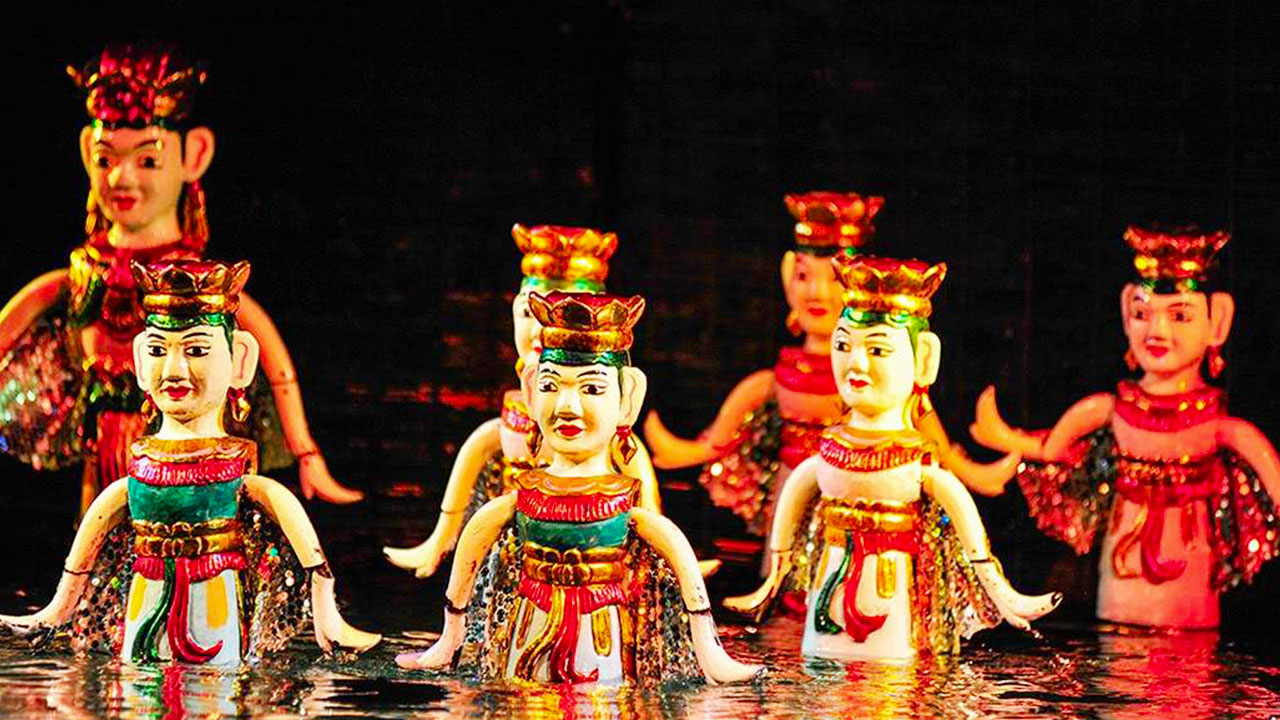
Water puppetry in Hanoi is not only a cultural performance but a living embodiment of Vietnamese history and tradition. Each show transports the viewer into a world where ancient myths and rural life unfold, offering a fascinating peek into the Vietnamese way of life from centuries past. As much as it’s a journey through history, it is also a heartwarming cultural exchange, inviting both locals and tourists to witness and appreciate the timeless stories and elegant craftmanship of Vietnamese culture. Let’s plunge into the mesmerizing world of water puppet theatre in Hanoi, exploring its origins, evolution, major venues, performance features, and practical visiting information.
History and origin of water puppetry
Water puppetry, or “Múa rối nước,” has its origins in the Red River Delta of northern Vietnam. This beautiful art form surfaced during the Lý dynasty and has since held a special place in Vietnamese culture, symbolizing the creativity and resilience of the Vietnamese people. The initial sketches were simple, created by farmers who used mud from flooded rice fields to form rudimentary puppets.
Traditional beginnings in the Red River Delta
The Red River Delta is the birthplace of Vietnamese water puppetry, reflecting a close relationship between the local culture and the agricultural landscape. Farmers devised water puppet shows as a form of entertainment and celebration during the monsoon season, when their rice paddies were flooded. This connection between water and stage craft is unique to this art form.

Historically, these performances were held in community ponds and flooded rice fields, where villagers would gather to watch the intricate dance of wooden puppets on water. Farmers carved puppets from fig wood and painted them with colorful lacquer. Some researchers suggest that the water element symbolized the rice and fertility, critical components of the agrarian society of that time. The performers, hidden behind bamboo screens, manipulated puppets using long, submerged bamboo rods, adding an air of mystery and magic to the shows.
Over time, water puppetry evolved from these makeshift performances to more sophisticated theatre experiences. As the craft advanced, so did the complexity and artistry of the puppets and performances. Yet, the heart of water puppetry remained the same a joyous celebration of rural life and folklore, brimming with mythology and cultural symbolism.
Evolution of puppetry in Vietnamese culture
The evolution of water puppetry in Vietnamese culture is a captivating narrative reflecting the country’s agricultural roots, socio-political changes, and cultural adaptations. Water puppetry, or “Múa rối nước,” originated over a thousand years ago during the Lý dynasty, specifically in the Red River Delta and other rice-growing areas of northern Vietnam. This art form was created by farmers who sought entertainment during the monsoon season when their fields were flooded, using the water as a stage for their puppet performances.
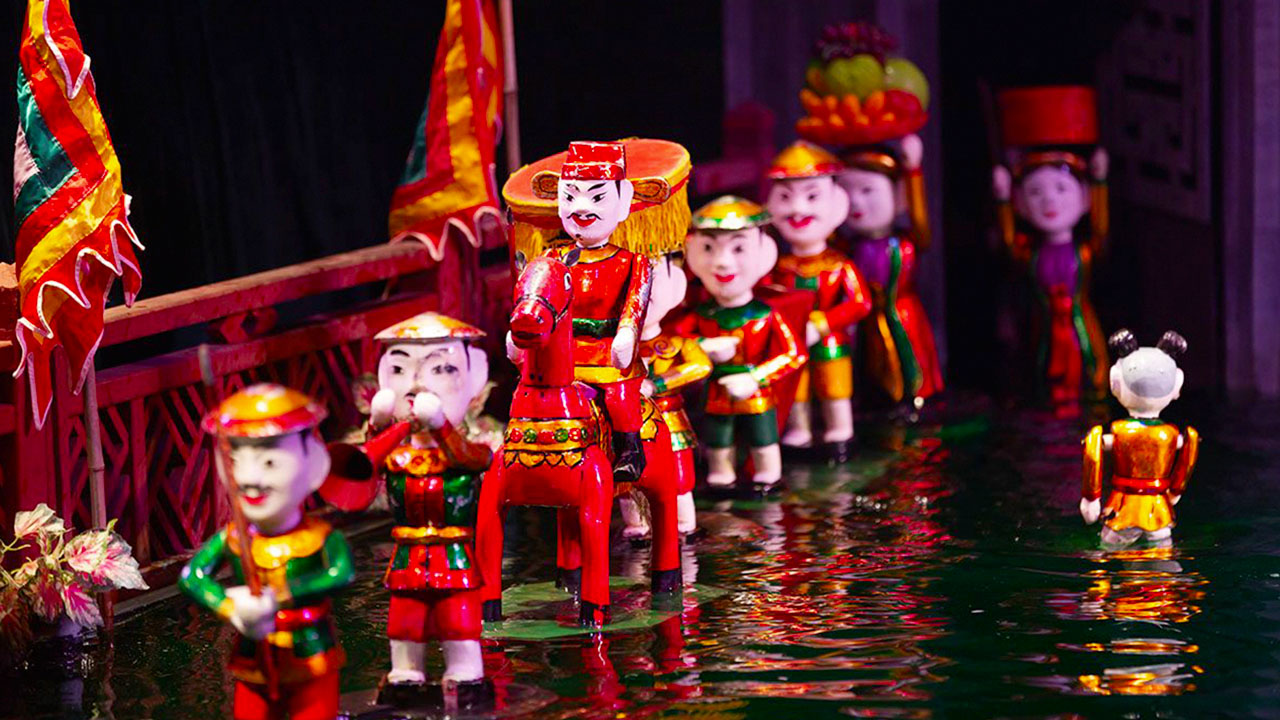
Historically, the performances served multiple purposes: they were a form of entertainment, a way to celebrate the harvest, and part of religious festivals. These early shows were simple in nature, with puppeteers using rudimentary puppets to depict scenes from daily life, such as fishing and farming. As the art form evolved, so did the puppets and performances, leading to the creation of intricately carved and lacquered wooden puppets controlled by skilled puppeteers hidden behind bamboo screens.
Throughout its history, water puppetry faced various challenges and transformations. During the French colonial period, it was deemed a primitive form of entertainment, leading to a decline in its popularity. Despite these challenges, the tradition persisted in rural communities, where it was preserved as an important cultural heritage. The post-colonial era saw a revival in interest, with professional puppetry theaters, such as the Thăng Long Water Puppet Theater, founded in Hanoi in 1969, gaining popularity. This theater has played a significant role in promoting water puppetry both locally and internationally, organizing performances that captivate a broad audience and maintain the traditional narratives that underpin this art form.
Influences and adaptations over centuries
The story of water puppetry is not simply one of tradition but also of adaptation and resilience. Over centuries, water puppetry has absorbed various influences and adapted to the changing cultural landscapes of Vietnam. During different historical epochs, the content, performances, and themes of water puppet shows transformed accordingly.
The early periods were marked by tales from Vietnamese folklore and local legends. However, the French colonial period brought new influences and challenges. Water puppetry was considered a primitive art form by the colonial rulers, and it struggled to survive. Despite the socio-political pressure, the tradition persisted in rural communities where these performances continued to be a part of religious and agricultural festivals.
The 20th century brought a resurgence of interest in traditional Vietnamese arts, including water puppetry. Professional water puppet theatres emerged, bringing the rural art form to urban audiences. The performances began to incorporate contemporary themes and narratives, touching on societal issues and environmental concerns while preserving historical folk tales and legends.
Summary Table: Evolution and Adaptations
| Period | Characteristics | Influences/Challenges | Developments/Changes |
|---|---|---|---|
| 11th century (Lý Dynasty) | Simple puppetry using mud and bamboo behind bamboo screens | Originated in the Red River Delta; close to agricultural roots | Basic entertainment, celebrating rural life and harvest |
| French Colonial Period | Deemed primitive, faced decline | Western influence viewed it as primitive | Survival in rural communities; adapted themes |
| Post-Colonial Era | Revival and urban popularity | Rising national pride in traditional arts | Establishment of professional theaters |
| Contemporary times | Blended traditional and modern themes | Global recognition (UNESCO Intangible Cultural Heritage) | Addressing modern issues while retaining traditional tales |
The enduring legacy of water puppetry speaks to the resilience and adaptability of Vietnamese culture. From its modest beginnings in the flooded rice paddies to its recognition as a global cultural treasure, water puppetry continues to enchant audiences, embodying the spirit of Vietnam through vibrant performances and masterful puppetry.
Major water puppet theatres in Hanoi
Hanoi is home to several renowned water puppet theatres, each offering unique experiences that highlight the intricacies and cultural depth of Vietnamese water puppetry. These venues not only serve as platforms for artistic performance but also as custodians of an ancient tradition, ensuring its preservation and dissemination to future generations.
Thăng Long Water Puppet Theatre
Probably the most famous water puppet theatre in Hanoi is the Thăng Long Water Puppet Theatre. Located at 57B Đinh Tiên Hoàng, near Hoan Kiem Lake, this theatre has become a landmark for both locals and tourists eager to delve into Vietnamese cultural heritage. The theatre was established in 1969 and has since gained international acclaim.
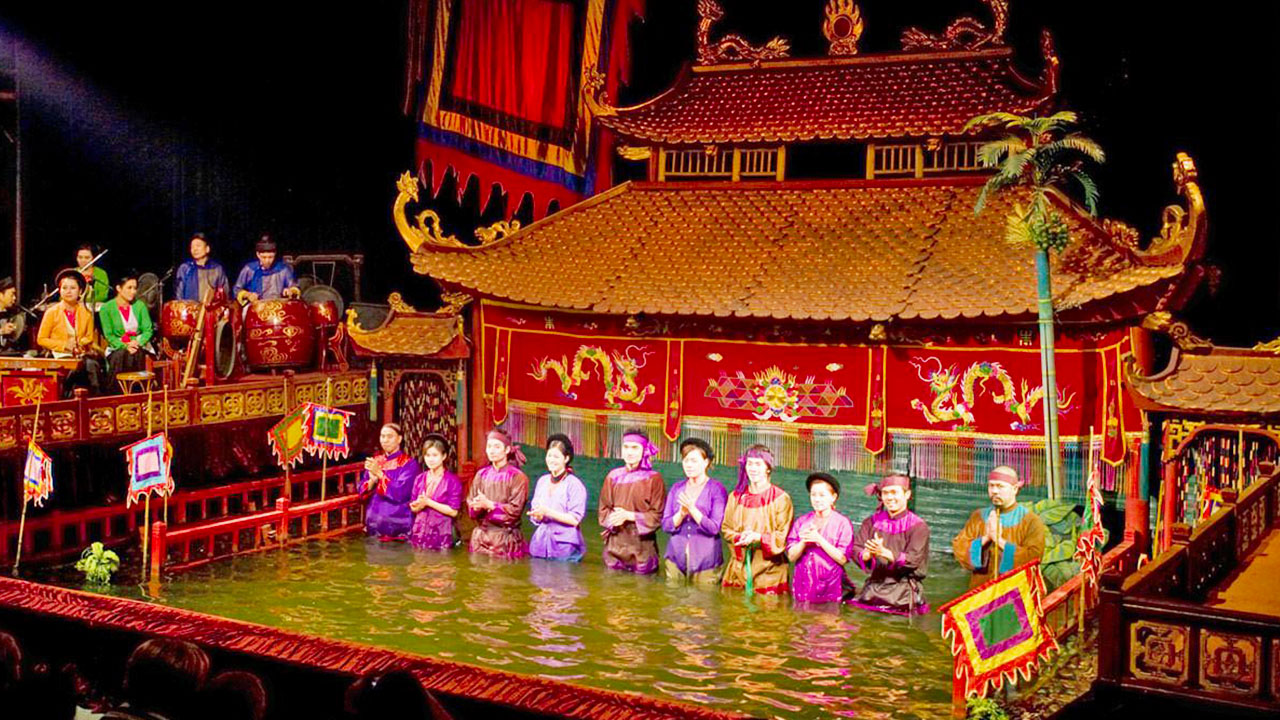
Location: Close to Hanoi’s historic heart, the theatre is easily accessible and often included in city tours.
Performance Details:
- The shows consist of a series of 17 short sketches depicting various folk tales, legends, and scenes from rural life.
- Guided by puppeteers hidden behind bamboo screens, the performances feature vibrant puppets that appear to float seamlessly on the water’s surface.
- A traditional Vietnamese orchestra enhances the shows with instruments like bamboo flutes, drums, and wooden bells.
- Each performance lasts about 50 minutes, catering to audiences of all ages.
Show Schedule: The theatre hosts multiple shows daily:
- Monday to Sunday: 15:30, 17:00, 18:30, 20:00, and 21:15
- Additional show at 9:30 on Sundays.
Ticket Information:
- Prices range from 100,000 VND (approximately $4.30 USD) for back seats to 200,000 VND (approximately $8.60 USD) for seats in the first five rows.
- Tickets can be purchased at the theatre, through phone, or online via the theatre’s official website.
Cultural Significance: The Thang Long Water Puppet Theatre has performed to audiences in over 40 countries, holding the Asian record for year-round water puppet performances, underscoring its cultural importance and broad appeal.
The Thang Long Water Puppet Theatre stands out not only due to its historical significance but also because of its international acclaim, making it a must-visit for those keen on experiencing traditional Vietnamese culture and performing arts.
Lotus Water Puppet Theatre
Lotus Water Puppet Theatre offers a more intimate and equally enchanting experience of water puppetry. Located at 16 Le Thai To Street in Hoan Kiem District, this venue is recognized for immersing audiences in the rich cultural heritage of Vietnam through its aquatic folk arts.
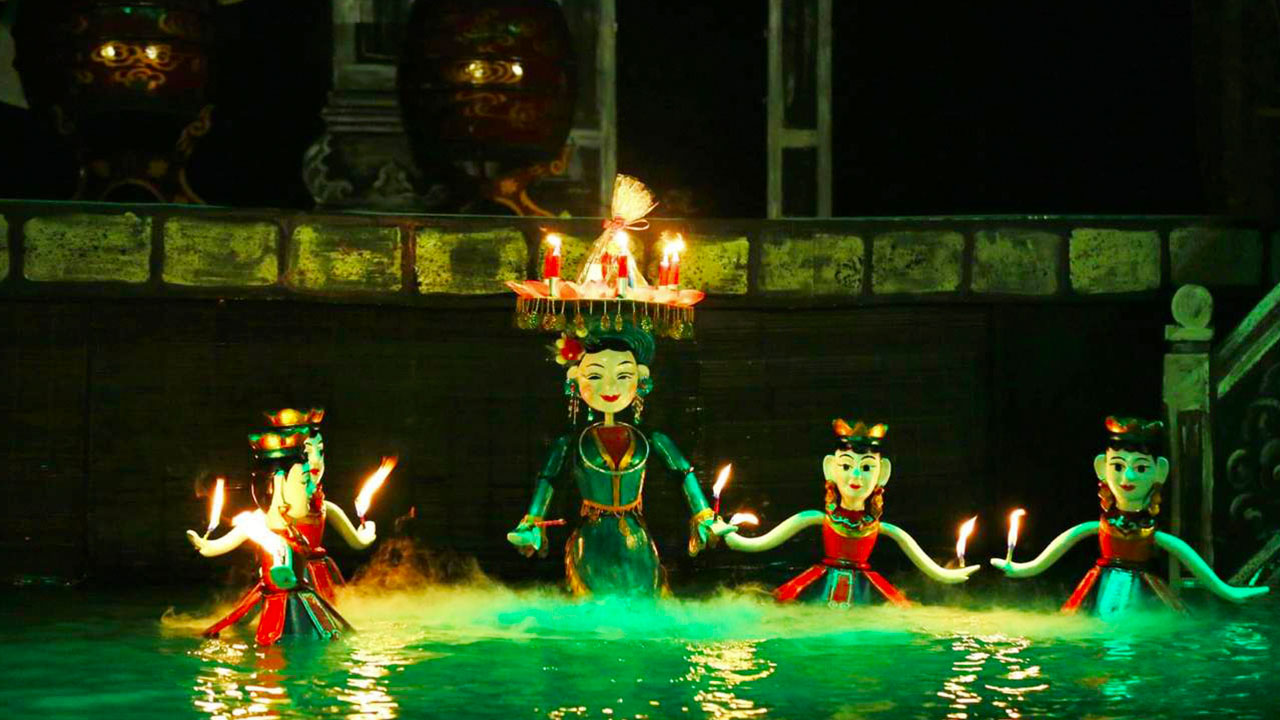
Location: Central location in Hoan Kiem District, close to significant tourist sites.
Performance Details:
- The shows retell beloved Vietnamese myths and village tales using hand-carved wooden puppets.
- Accompanied by live traditional music performed on instruments such as the drum and bamboo flute.
- The setting includes a small pool surrounded by decorative elements enhancing the experience.
- Showtimes include 2:45 PM, 4:00 PM, 5:15 PM, and 6:30 PM.
Ticket Prices:
- VIP seating and regular options are available, with prices varying accordingly.
- Standard ticket: 100,000 VND (approx. $4.30 USD).
- VIP ticket: 150,000 VND (approx. $6.50 USD).
Ambiance: The intimate setting of the Lotus Water Puppet Theatre allows for a more personal experience, with the audience getting a closer view of the intricate puppet movements and traditional craftsmanship.
Canh Dieu Water Puppet Theatre
Canh Dieu Water Puppet Theatre is another notable venue for this traditional art form, located at 19B Ngoc Ha Street in the Ba Dinh District of Hanoi.
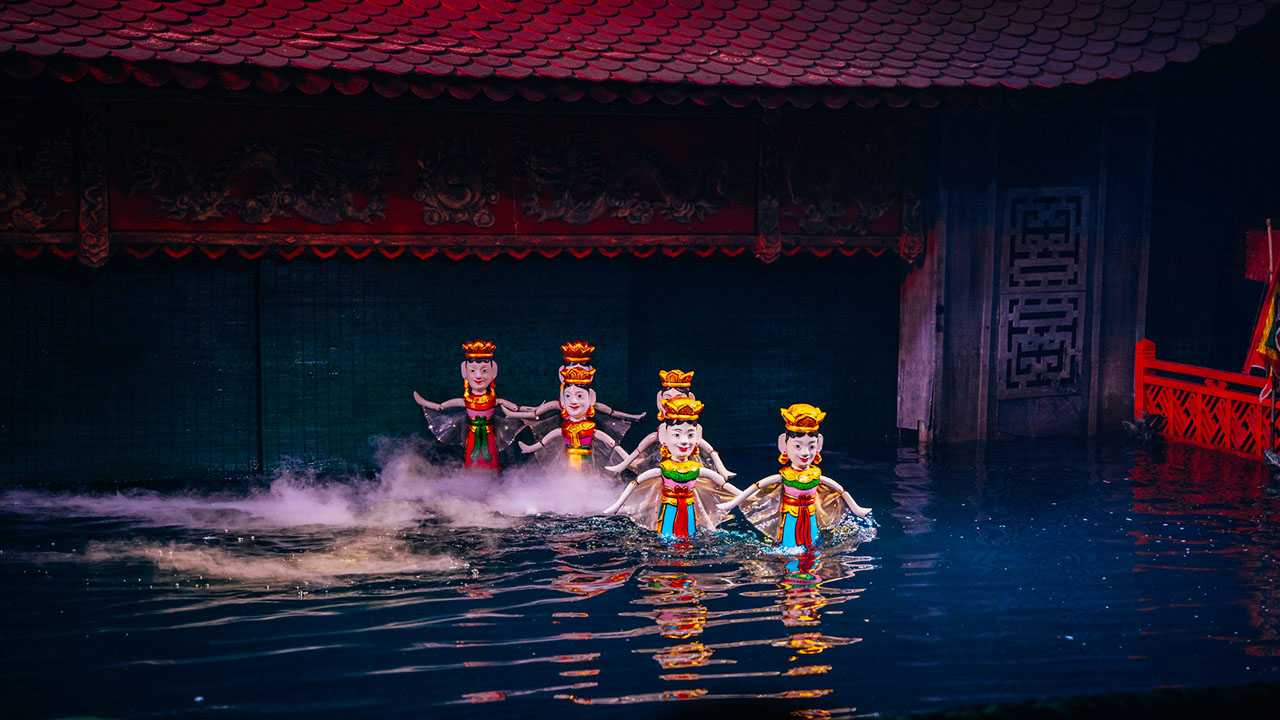
Location: Near significant tourist attractions, providing easy access for visitors.
Performance Details:
- Performances last around 50 minutes, featuring themes related to Vietnamese farmers’ daily lives, folklore, and legends.
- Puppeteers use time-honored techniques, showcasing their skill in manipulating the puppets to depict lively and engaging stories.
Setting: The theatre offers a traditional architectural design that complements the cultural authenticity of the performances, providing a fitting backdrop for the stories told.
Ambience: Known for vibrant storytelling and audience interaction, Canh Dieu creates an engaging atmosphere for spectators, blending humor, drama, and emotional storytelling within each performance.
Summary Table: Major Theatres
| Theatre Name | Location | Show Times | Ticket Prices (VND) | Special Features |
|---|---|---|---|---|
| Thăng Long Water Puppet Theatre | 57B Đinh Tiên Hoàng, Hoàn Kiếm | Mon-Sun: 15:30, 17:00, 18:30, 20:00, 21:15; Sun: 9:30 | 100,000 – 200,000 | Celebrated shows with traditional orchestra |
| Lotus Water Puppet Theatre | 16 Le Thai To, Hoan Kiem District | 2:45 PM, 4:00 PM, 5:15 PM, 6:30 PM | 100,000 (Standard), 150,000 (VIP) | Intimate setting, vibrant traditional elements |
| Canh Dieu Water Puppet Theatre | 19B Ngoc Ha, Ba Dinh District | Various times throughout the day | Not specified; usually in similar range | Close proximity to other tourist sites; vibrant storytelling; live interactions |
These theatres collectively ensure the preservation and continual enjoyment of the timeless art of water puppetry. Visiting any of these venues in Hanoi promises an unforgettable dive into Vietnamese culture, weaving tales of age-old myths, daily rural life, and evocative traditions.
Performance features and experience
The performance of water puppetry is a multifaceted experience combining puppetry, music, and storytelling to create a magical and emotionally resonant spectacle. Attending a water puppet show in Hanoi is not just about observing an ancient art form but immersing oneself in a rich cultural journey.
Puppetry techniques and mechanisms

Water puppetry employs unique techniques and sophisticated mechanisms setting it apart from any other puppet form. The puppeteers stand waist-deep in water, concealed behind a bamboo screen, maneuvering the puppets with long bamboo rods and strings. These rods remain hidden beneath the water, creating an illusion that the puppets are self-propelled.
Manipulation Techniques:
- Puppeteers use a series of long and short bamboo rods and strings to control the puppets’ movements.
- The technique requires balancing behind the screen while manipulating the puppets in water, demanding high levels of skill and coordination.
Puppet Design:
- Puppets are crafted from lightweight wood and intricately painted for vibrant performances.
- Commonly made from fig wood known for its buoyancy and lightness, they are adorned with lacquer to make them water-resistant.
- This type of craftsmanship ensures that each puppet is a piece of art, both functional and visually appealing.
Show Dynamics:
- The water adds a dynamic element, reflecting sunlight and artificial light to enhance the theatrical atmosphere.
- The movements of the puppets on water create reflections that add a dreamy, ethereal quality to the performances.
The intricate craftsmanship and sophisticated manipulation make water puppetry not just a visual treat but a technical marvel, showcasing the puppeteers’ artistry and dedication.
Music and cultural significance
A distinct feature enhancing water puppetry is the accompaniment of live traditional Vietnamese music. This music provides an emotional backdrop and deepens the cultural resonance of the stories told.
Instruments Used:
- Traditional instruments such as bamboo flutes, drums, and stringed instruments create a melodic symphony complementing the puppet movements.
- Each instrument is carefully selected to match the mood and pace of the narrative, ensuring a cohesive performance.
Live Performance:
- Live music allows for subtle adaptations and improvisations, adding a dynamic and responsive quality to each performance.
- Musicians often play from within the theatre, making it a sensory-rich experience.
Cultural Impact:
- Water puppetry serves as a vital cultural artifact, preserving Vietnamese music traditions and styles.
- The fusion of visual performance and music offers a holistic cultural experience, emphasizing community values, historical events, and moral lessons.
Storytelling and themes in performances
Storytelling is at the heart of water puppet shows, with themes often derived from Vietnamese folklore, historical legends, and rural life. Each performance typically consists of several short plays, narrated through puppet movements and musical cues.
Narrative Themes:
- Common narratives include tales from Vietnamese mythology, stories of legendary heroes, and depictions of daily village life.
- Example: The legend of the restored sword, or the heroic tales of Thach Sanh.
Moral and Educational Aspects:
- The performances often convey moral lessons and community values, educating younger generations about Vietnamese culture and traditions.
- Themes of resilience, bravery, and communal harmony recur frequently, reflecting societal norms and aspirations.
Visual and Emotional Engagement:
- The colorful, intricately designed puppets enhance visual appeal, drawing audiences into the narrative.
- Emotional depth is added through the live music and precise puppet movements, creating a lively, engaging atmosphere.
List: Common Themes in Water Puppetry
- Agriculture: Reflecting the agricultural roots of Vietnamese society with scenes of planting, harvesting, and fishing.
- Historical Legends: Narratives of national heroes, kings, and mythical figures.
- Community and Festivals: Depictions of village festivals, communal dances, and folk games.
- Morality Tales: Stories imparting moral lessons about honesty, courage, and communal harmony.
The blend of engaging visuals, evocative music, and meaningful storytelling distinguishes the water puppet theatre as a proud emblem of Vietnamese culture and heritage.
Ticket information and booking options
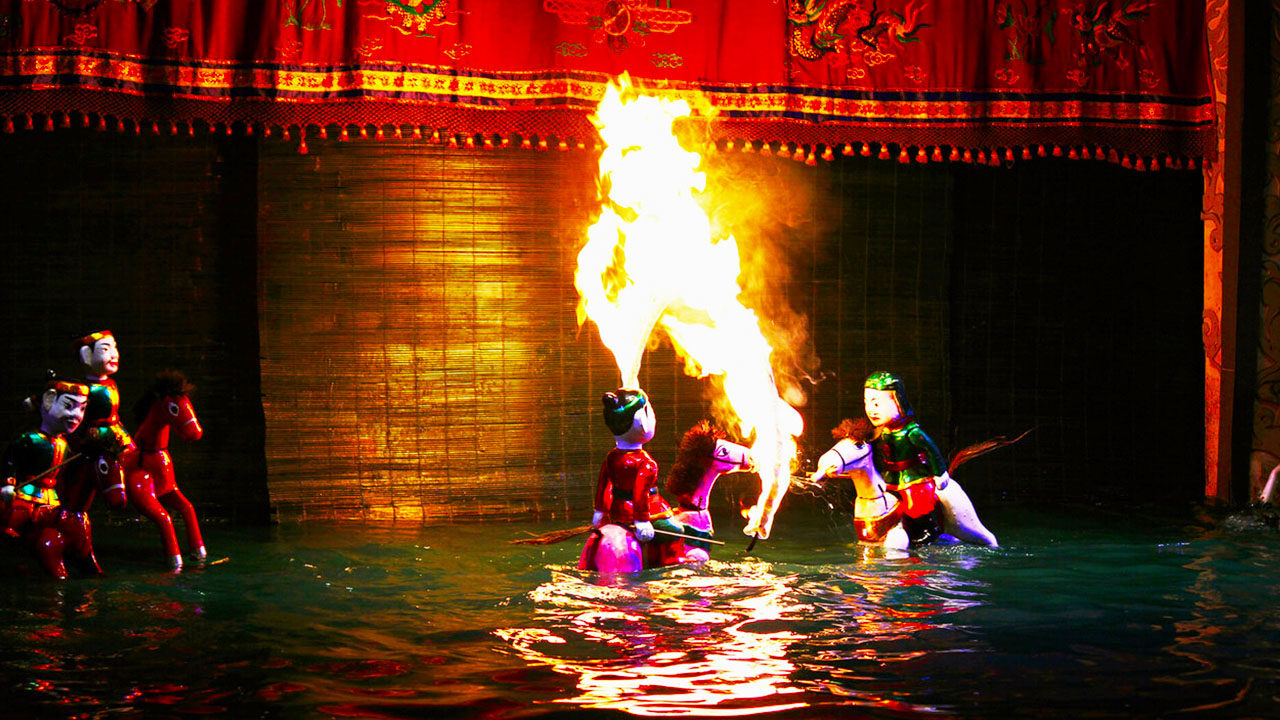
Attending a water puppet show in Hanoi requires a bit of planning, particularly regarding ticket acquisition and understanding the available options. This section provides comprehensive details to help you make the most informed decision, ensuring a seamless and enjoyable experience at the water puppet theatre.
Ticket prices and discounts
Ticket prices for water puppet shows in Hanoi can vary based on several factors, such as seating preference, time of the performance, and specific theatre. Here’s a broad overview of typical pricing structures and potential discounts.
Price Range:
- Prices generally range from 100,000 VND to 200,000 VND (approximately $4.30 to $8.60 USD).
- The cost is often higher for seats closer to the stage and during peak times.
Seating Categories:
- VIP Tickets: Typically the first row or front seats, providing the best view of the performance (approx. 200,000 VND).
- Standard Tickets: Middle rows with a good overall view (approx. 150,000 VND).
- Economic Tickets: Back rows offering a wider but slightly more distant view (approx. 100,000 VND).
Discounts:
- Early Bird Discounts: Booking tickets in advance often fetches discounts or promotional deals.
- Group Discounts: Some theatres offer reduced rates for large groups or educational tours.
- Seasonal Offers: Special occasions like Tet (Vietnamese New Year) may see discounted rates or packages.
Online booking process
Booking tickets ahead of time is recommended, especially during peak tourist seasons. Several options are available to ensure you secure your place at a water puppet show.
Official Theatre Websites:
- Most major theatres, such as Thang Long Water Puppet Theatre, offer online booking facilities.
- Websites typically provide updated show schedules, ticket availability, and direct booking options.
Tourist Platforms:
- Websites like Klook and GetYourGuide allow for convenient ticket booking.
- These platforms might offer promotional rates or packages that include tours and additional services.
Booking Steps:
- Visit the official or third-party website.
- Choose your preferred date and showtime.
- Select seating category and number of tickets.
- Complete the payment process, often facilitated through credit/debit cards or international payment gateways like PayPal.
Confirmation:
- Upon successful booking, you’ll receive a confirmation email or a digital ticket.
- Carry a printout or digital copy of the ticket when attending the show.
Contact information for reservations
For those looking to book tickets directly or need specific assistance with their water puppet theatre reservations in Hanoi, contacting the theatres directly can be very efficient. Here is the essential contact information for the primary theatres.
Thang Long Water Puppet Theatre:
- Address: 57B Đinh Tiên Hoàng, Hoàn Kiếm, Hanoi, Vietnam
- Phone: (+84) 24 3824 9494
- Email: marketingthanglongwpt@gmail.com
- Website: nhahatmuaroithanglong.vn
Lotus Water Puppet Theatre:
- Address: 16 Le Thai To Street, Hoan Kiem District, Hanoi, Vietnam
- Phone: (+84) 972 03 04 20
- Email: muaroinuocbongsen@gmail.com
- Website: bongsenwaterpuppet.vn
Canh Dieu Water Puppet Theatre:
- Address: 19B Ngoc Ha Street, Ba Dinh District, Hanoi, Vietnam
- Phone: (+84) 24 3846 8158
- Email: booking@canhdieuwaterpuppet.com
- Website: www.canhdieuwaterpuppet.com
Feel free to reach out directly to these theaters via phone or email for inquiries about show schedules, ticket availability, group bookings, and any other specific requirements.
By facilitating direct communication, these theatres aim to offer a seamless booking experience, ensuring that every visitor has easy access to one of Hanoi’s most treasured cultural experiences.
Show schedules and timing
Understanding the show schedules is crucial for planning a visit to any of the major water puppet theatres in Hanoi. The performances are typically held multiple times a day to accommodate both local audiences and tourists.
Weekly performance timetable
The Thang Long Water Puppet Theatre, being one of the most popular venues, offers a robust timetable to cater to various preferences. Here’s a typical schedule:
| Day | Show Times |
|---|---|
| Monday | 15:00, 16:10, 17:20, 18:30, 20:00 |
| Tuesday | 15:00, 16:10, 17:20, 18:30, 20:00 |
| Wednesday | 15:00, 16:10, 17:20, 18:30, 20:00 |
| Thursday | 15:00, 16:10, 17:20, 18:30, 20:00 |
| Friday | 15:00, 16:10, 17:20, 18:30, 20:00 |
| Saturday | 15:00, 16:10, 17:20, 18:30, 20:00 |
| Sunday | 9:30, 15:00, 16:10, 17:20, 18:30, 20:00 |
These multiple daily showtimes allow visitors flexibility in planning their visit, ensuring they can fit the performance seamlessly into their itinerary.
Special shows and events
Aside from regular performances, these theatres often host special shows and events that are worth noting.
Festivals and Celebrations:
- Tet (Vietnamese New Year): Special performances during the Tet holiday featuring themes of renewal and prosperity.
- Mid-Autumn Festival: Unique shows focusing on moon legends and harvest-related themes.
Special Performances:
- Occasionally, theatres may organise themed shows based on folk tales or historical events, enhancing the cultural depth of the performances.
- Guest Performances: Invited troupes from other regions or countries might perform, offering a diverse artistic experience.
Educational Events:
- Some theatres host workshops and interactive sessions for children and students, furthering the educational aspect of this traditional art form.
- Masterclasses: For those deeply interested in puppetry, masterclasses with experienced puppeteers provide valuable insights into the techniques and history of water puppetry.
Best times to visit for optimal experience
Choosing the best time to visit for a water puppet show can affect the overall experience significantly. Here are some tips for planning the perfect visit:
Weekdays vs. Weekends:
- Weekdays: Generally less crowded, offering a more relaxed viewing experience.
- Weekends: Typically busier due to both local families and tourists, but the bustling atmosphere can add to the excitement.
Off-Peak Hours:
- Early afternoon shows (around 15:00) or later evening shows (post 20:00) are less crowded, ensuring better seating availability and a quieter atmosphere.
Seasonal Considerations:
- Avoid major holidays if a quieter experience is preferred, but if you enjoy festive environments, visiting during Tet or other key celebrations can be very fulfilling.
- During tourist high seasons (April to June, September to November), booking tickets well in advance is advisable.
Summary Table: Visit Timing Tips
| Timing | Characteristics | Recommended For |
|---|---|---|
| Weekdays | Less crowded, more relaxed atmosphere | Visitors preferring a calm experience |
| Weekends | More crowded, lively and energetic | Those enjoying a bustling scene |
| Early Afternoon (15:00) | Quieter, easier to find good seats | Families, relaxed viewers |
| Evening Shows (20:00) | Less rush, great end to a day of sightseeing | Couples, night owls |
| Festive Seasons | Special performances, cultural immersion | Culture enthusiasts |
| Tourist High Seasons | Busy, potential for vibrant interactions | International tourists |
Choosing the best time to visit fundamentally depends on personal preferences, whether it’s about securing a quiet spot or indulging in the cultural vibrancy of a bustling festival crowd.
Cultural importance of water puppetry

Water puppetry is not merely a form of entertainment but a significant part of Vietnam’s rich cultural tapestry. This traditional art form is a living legacy that encapsulates the values, history, and communal life of the Vietnamese people.
Artistic heritage and preservation efforts
Vietnamese water puppetry, known as “Múa rối nước,” reflects a profound artistic heritage that dates back over a millennium. Originating in the Red River Delta, it is symbolic of the deep-rooted connection between Vietnamese culture and its agrarian society.
Artistic Heritage:
- Water puppetry transcends mere performance, embodying the storytelling tradition vital to Vietnamese culture.
- It highlights rural life scenes, myths, and legends using intricately designed wooden puppets and traditional music.
- Performances often serve as celebrations of Vietnamese folklore, presenting the intricate relationship between people and their environment.
Preservation Efforts:
- Continued efforts to preserve and promote water puppetry are seen in regular performances at dedicated theatres like Thang Long.
- Educational initiatives aim to pass on the skills of puppet making and manipulative techniques to younger generations.
- UNESCO recognizes it as an Intangible Cultural Heritage, reflecting its significance and the importance of ongoing preservation.
Water puppetry in modern Vietnamese society
Modern Vietnamese society holds water puppetry in high regard, seeing it as both a vital cultural record and a vibrant form of contemporary entertainment.
Cultural Relevance:
- Contemporary performances often incorporate traditional tales with modern themes, ensuring relevance to today’s audiences.
- Water puppetry continues to serve as a medium for storytelling and cultural education, upholding the heritage while evolving with the times.
Tourism and Economic Impact:
- Theatres like Thang Long and Lotus are major tourist attractions, drawing visitors worldwide.
- Performances boost local economies, providing livelihoods for artists, musicians, and associated staff.
Community Engagement:
- It remains popular in urban and rural areas alike, with frequent shows during cultural festivals and community gatherings.
- Educational programs and interactive shows for children ensure the younger generation remains connected to their cultural roots.
Recognition and global influence of water puppetry
The global influence of water puppetry is evident through various international recognitions and performances worldwide.
International Acclaim:
- UNESCO’s recognition as an Intangible Cultural Heritage highlights its importance on a global scale.
- The Thang Long Water Puppet Theatre has performed in over 40 countries, showcasing Vietnamese culture worldwide.
Cultural Ambassadors:
- International tours by Vietnamese water puppet troupes serve as cultural ambassadors, fostering cross-cultural appreciation and exchange.
- Performances at global events and festivals expose international audiences to this unique art form, promoting cultural diplomacy.
Expanding Horizons:
- Increased international interest has led to collaborations and artistic exchanges that enrich the tradition while fostering innovation.
- Digital platforms and media coverage help in spreading knowledge about water puppetry, attracting new enthusiasts globally.
List: Key Aspects of Global Influence
- UNESCO Recognition: Significance of water puppetry as an Intangible Cultural Heritage.
- International Tours: Performances in 40+ countries, promoting Vietnamese culture.
- Cultural Exchange: Collaborative efforts and artistic exchanges with international puppetry traditions.
- Digital Presence: Online platforms and media coverage expanding global reach and understanding.
The enduring popularity and global influence of water puppetry underscore its importance as both a cultural artefact and a vibrant, living tradition that continues to capture hearts and spark imaginations across the world.
In conclusion, water puppetry in Hanoi serves as a bridge between the ancient and the modern, the rural and the urban, the local and the global. It is more than entertainment; it is a living narrative of Vietnamese history, culture, and communal values. From its origins in the Red River Delta to its modern-day performances at renowned theatres like Thang Long and Lotus, water puppetry remains a captivating expression of Vietnam’s profound cultural heritage. Whether you are a tourist seeking a cultural experience or a local cherishing traditional art, witnessing a water puppet show is an unforgettable journey through Vietnam’s vibrant history and artistic spirit.


